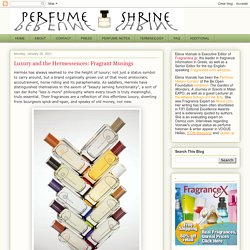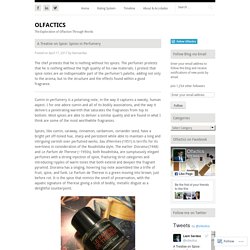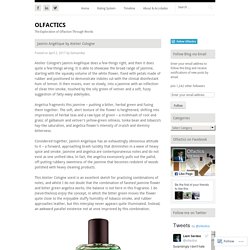

Fragrant Musings. Hermès has always seemed to me the height of luxury: not just a status symbol to carry around, but a brand organically grown out of that most aristocratic accoutrement, horse riding and its paraphernalia.

As saddlers, Hermès have distinguished themselves in the axiom of "beauty serving functionality", a sort of van der Rohe "less is more" philosophy where every touch is truly meaningful, truly essential. Their fragrances are a reflection of this effortless luxury, diverting from bourgeois spick-and-span, and speaks of old money, not new. The fact that Réna Dumas (née Gregoriadès), architect and mother of Pierre Alexis Dumas, was of Greek extraction, alongside her pushing a Hellenic aesthetic to the brand through collaborations with artists and illustrators, has solidified this classical approach in my mind.
She detested pomposity, she embraced serenity and douceur de vivre. Fragrance review. Portrait of a Lady in the line Editions des Parfums Frederic Malle is named after the homonymous novel by Henry James from 1881; a romantic detail which never fails to stir the imagination as related to fragrance.

The novel tells the story of Isabel Archer, a young American heiress who "affronts her destiny". Dealing with one of James' recurrent themes, an American in Europe (as in Wings of the Dove), and the differences between the two cultures, The Portrait of a Lady is a tale of the conspiracy to separate Isabel from her fortune, and subsequently the value of autonomy and accountability. The olfactory inspiration however has little to do with ladies, and lots to do with the burgeoning trend, set years before with Serge Lutens opening Les Salons de Palais Royal (find the perfume addresses of Paris here), of Arabian-inspired perfumery. Unveiling the secret of vetiver's scent. Top 10 Best Summer Fragrances. Most Complimented Fragrances for Black Tie. Le Jardin Retrouvé – Cuir de Russie. Le Jardin Retrouvé or “the recovered garden” might well be a new discovery for many niche fragrance followers even though the house has existed since 1975.

Le Jardin Retrouvé has been very quiet since the brand’s founder, perfumer Yuri Gatsatz, passed away in 2005. The brand was a sleeping beauty until Yuri’s son Michel and his wife, Clara, brought new life into the Parisian fragrance house in 2016. The couple were so determined in their work they even sold the family house to finance the project. Yuri’s life story is a fascinating tale. Surviving tumultuous years of political revolution and world wars, the young Russian immigrant eventually settled in Paris at the age of 19. A Treatise on Spice: Spices in Perfumery. The chef protests that he is nothing without his spices.

The perfumer protests that he is nothing without the high quality of his raw materials. I protest that spice notes are an indispensable part of the perfumer’s palette, adding not only to the aroma, but to the structure and the effects found within a good fragrance. Cumin in perfumery is a polarising note, in the way it captures a sweaty, human aspect. I for one adore cumin and all of its bodily associations, and the way it delivers a penetrating warmth that saturates the fragrances from top to bottom. Most spices are able to deliver a similar quality and are found in what I think are some of the most worthwhile fragrances.
Spices, like cumin, caraway, cinnamon, cardamom, coriander seed, have a bright yet off-toned hue, sharp and persistent while able to maintain a long and intriguing varnish over perfumed works. Goldfield & Banks – Desert Rosewood. Australia is developing into one of the new frontiers for fine fragrances and Goldfield & Banks is a new brand that is shaping the country’s budding reputation.

Created, formulated and bottled here in Australia, Goldfield & Banks tells an Australian story through the eyes of French-Belgian entrepreneur Dimitri Weber. Dimitri migrated to Sydney two years ago where he created a collection of four fragrances inspired by Australia’s native flora and distinct landscapes. He describes the collection as being “unravelled nature”. His fragrances are a “botanical dream from downunder”.
Dimitri came to Australia with a wealth of industry experience. Jasmin Angélique by Atelier Cologne. Atelier Cologne’s Jasmin Angélique does a few things right, and then it does quite a few things wrong.

It is able to showcase the broad range of jasmine, starting with the squeaky volume of the white flower, fixed with petals made of rubber and positioned to demonstrate indoles cut with the clinical disinfectant hum of lemon. It then moves, ever so slowly, into a jasmine with an inflection of clean thin smoke, touched by the oily green of vetiver and a soft, fuzzy suggestion of fatty-waxy aldehydes. Angelica fragments this jasmine – pushing a bitter, herbal green and fusing them together. Meaning in Fragrance: Maduro by Fort & Manlé. There are considerable, crucial moments in perfume writing and consideration that it begins to change and shape the way you think about scent.

A shift towards the most critical is what has shaped my writing on the blog, and in order to achieve that a breadth of perspective is demanded. Examination is rightly followed by questioning, and it brings me great enjoyment tackling the groundworks of the ethics of a perfume reviewer. Models of communication highlight the relationship between the sender and the receiver. Gris Clair by Serge Lutens. I cannot think of a fragrance that captures solitude and reflection more effectively than Gris Clair, altogether able to find itself quiet yet intense.

It is indeed a scent of light grey, but in no way evoking a melancholic mood. Instead, it is the olfactory equivalent of isolated deep thought. The endearing feature of Gris Clair is how it is capable of grey but not of melancholy or nostalgia. This separation of its features intrigues me, because the grey of the lavender and the perfume in itself smoothly shifts into a scent of soft burning – a metallic warmth at its core.
This is not at all overt, nor does one effect take primacy over the other. Monthly Musings: Justification, February 2017. A whole mishmash for blog readers in this post!

Upon self-reflection, a theme I have picked up on is reflexivity, spurred quite clearly by the comments from others on my blog posts. I make an intense effort to ensure utmost transparency and have quite clearly from time to time dedicated entire Monthly Musings posts to the gruelling task of grappling the slippery concept of justification. Successful or not, as long as I have openly delivered a discourse on the principles in which I stand for by stating them on and on again I have been, in some valid circular way (and as narrow in scope as it may be), justified in every single review of any scented stimuli on this very blog. It is not my task as a serious critic to urge you to buy anything, but like the decanter to the wine, it is my job to express the oratory function of fragrance; to impose well-founded and self-founded values and hold a scent to that very account and see if it makes the cut.
These necessary conditions are paramount. Inexcusable Ropion: Cologne Indélébile from Frederic Malle and Soul by Costume National. No perfumer is without their faults.

Cologne Indélébile From Frederic Malle Original Score: 5/5 First Posted July 2, 2015 Maxim: Divorce functionality from critical scent analysis. Fragrance isn’t practical, and judging Cologne Indélébile on that merit was plainly spurious of me. That ought not to be a condition in judging perfume, because when has art ever been functional or practical? It is then only appropriate that my view of Cologne Indélébile trims itself down from the original perfect 5 that I gave it.
The Cologne Guide — Gentleman's Gazette. In this guide, we’re going to examine cologne for the distinguished gentleman, what he should seek out, how he should apply it, and our recommended picks. A selection of fine colognes History of Cologne Perfumes have been in existence since ancient Mesopotamia and Egypt. Although at the time it was a rudimentary concoction, it wasn’t until the Romans and Persians when perfume was essentially viewed as a science of alchemy.
Monthly Musings: Conditions & Maxims, January 2017. The 2nd edition of Karen MacNeil’s The Wine Bible has recently come into my possession. I appreciate and find it totally collectible to obtain as many reference books and encyclopaedias as I can on topics that interest me. Philosophy encyclopaedias are a given, wine books are relatively easy to come by, and texts on fragrance seem to move closer into the realm of the textbook than anything else. What I enjoy about such texts is the ability to draw the perspective of multiple authorities on the same topic. Johnson’s, Robinson’s, and MacNeil’s perspective of Northern Rhône reds expectedly vary. Burr’s, Turin’s, and Olfactics’ perspective of Kouros ought to vary, and I expect they do. Arquiste – Él, Ella and Esencia de el Palacio. The story of Arquiste is one that traverses many continents but the fragrance house’s most intrinsic stories often take place in Mexico, the birthplace of Arquiste’s founder, Carlos Huber.
As the saying goes, home is where the heart is, no matter how far afield life takes you. Having worked almost exclusively with Givaudan perfumer and fellow countryman Rodrigo Flores-Roux, Carlos uses scent as a time capsule that speaks of Mexico’s past, present and even its future. Examples of these stories are Flor y Canto and Anima Dulcis; the wearer is transported to a Baroque convent in Mexico City and they take part in Aztec flower rituals in Tenochtitlan’s ancient temples. Carlos’ background as an architect and historic preservation prevails and Arquiste’s stories describe these historical events in meticulous olfactory detail. 2016 was a busy year for Arquiste. New to the collection were two fragrances called Él and Ella. “I thought this was an interesting story. Phoenicia by Heeley. Phoenicia smells like an old fragrance situated in an old place, drawing its inspiration from ancient cues and ingredients.
Why Are Celebrity Perfumes Still Popular? Back a while ago I really thought the trend for celebrity scents (i.e.scents coat-tailing on the success of a celebrity brand name to which they're designed as an accessory) was dying. Boy, was I wrong! There are more celebrity scents coming out each season and it stands to reason people must be actually buying all this stuff for the companies to keep churning out more and more.
(The latest, Nicole, comes from Nicole Richie who credits her mother's layering of a hundred scented products as its inspiration, which is scary sounding enough). But WHY are they? "Like their wearers, these fragrances are not sophisticated, nor are they complicated. ''Parallel market'' fragrances are flourishing, according to beauty market analyst Jo-Anne Mason. Perfume Shrine: Sarah Jessica Parker Lovely: fragrance review. Few fragrances boast their very definition in their name, unless they're programmatic, but so few celebrity scents are anyway. Department Store Salesmanship: Wanted by Azzaro. Perfume Shrine: Fendi Theorema: fragrance review.
Now that perfumer Christine Nagel is at the helm of Hermès, looking back on her work for various brands reveals her core aesthetics; at once saturated and filled with light, like a Joseph M.W. Turner painting that foreshadows what's to come, namely Impressionism. Judging by her newest Eau de Rhubarbe Ecarlate and Galop, this heftiness-shot-with-brightness continues the sun path to its natural apex. CHANEL: Le Baudruchage. Habit Rouge Dress Code by Thierry Wasser for Guerlain 2015. Robert Herrmann. Dzongkha by L’Artisan Parfumeur. It seems plain to me that certain noses have an aptitude for certain styles and notes.
Parle Moi de Parfum, Grasse – Paris, Exploring the Collection. Grasse may be the historical home of French perfumery but this sleepy town in the South of France does not give up its scented stories to everyone. The history of Grasse is told by a handful of perfume museums in the old town but the real work of perfumery takes place in the surrounding countryside, away from the tourists, behind securely gated factories and laboratories owned by the likes of Mane and Robertet. Noir Epices for Frederic Malle. Along with Musc Ravageur, Noir Epices structurally may be the greatest creation in the Malle line. Eau d’Italie’s ALTAIA – Exploring the Collection. This spring I was invited to meet storytellers Marina Sersale and Sebastián Alvarez Murena, the founders of Italian niche perfume house Eau d’Italie. Overview: Le Jardin Retrouvé. Safran Troublant by L’Artisan Parfumeur.
The Cologne Guide — Gentleman's Gazette. Mitsouko by Guerlain. What Men Should Smell Like. Perfume Shrine: L'Artisan Parfumeur Saffran Troublant: fragrance review. Sex and the Sea by + for Francesca Bianchi 2016. The Soliflore: Sa Majesté la Rose by Serge Lutens. DSH Perfumes. Samsara EdP by Jean-Paul Guerlain for Guerlain 1990. Atelier Cologne – Tobacco Nuit. Perfume Shrine: YeYe Parfums Sentiers de Cometes: fragrance review. What Men Should Smell Like. La Tulipe by Byredo. Monthly Musings: A Grand Narrative? September 2016. Unexpected Iris: Paprika Brasil by Hermès. In Defence of Traditionalism: No. 5 L’Eau by Chanel. Grandiflora Fragrance and Bertrand Duchaufour – Queen of the Night interviews. On Vetiver: Vétiver Extraordinaire for Frederic Malle.
Myrrh Casati by Melanie Leroux for Mona di Orio 2014. Noir De Noir by Tom Ford. On Oud: Oud 27 by Le Labo. What Men Should Smell Like. Amouage – Myths Man and Myths Woman. Goddess? My Perfume Pantheon + GIVEAWAY. Strange Fruit: Jubilation 25 by Amouage. Hyper-Natural Scent from Design to Art by Chandler Burr. Monthly Musings: On Approach, July 2016. Poet’s Jasmine by Ineke Rutland for INeKE 2011. Opus X by Pierre Negrin + Annick Menardo for Amouage 2016. FLANKERS!! Let’s Talk About Flankers. Comme des Garçons by Comme des Garçons. Jo Malone London – Mimosa & Cardamom. CHANEL: The Self-Portrait of a Perfume.
Dior Eau Sauvage: Tribute to a Legend: Video. Œillet Sauvage by Anne Flipo for L’Artisan Perfumer 2000. History, Travel, Arts, Science, People, Places. Perfume Shrine: Lady Gaga Fame: fragrance review. Lady Gaga's Celebrity Perfume: Smelling like an Expensive Hooker. Best in Show: Tropical Island Scents (2016) ~ Best in Show. China White by Nasomatto: Postmodern Chypre. Ermenegildo Zegna – Mediterranean Neroli. Safari Woman by Dominique Ropion for Ralph Lauren 1990. Rena “Carol” Aulick-Lynn 1949 – 2016. The World of a Japanese Perfumer: Part 1, an Interview with Satori Osawa ~ Interviews. What Men Should Smell Like. Fragrances of the World 2016 Edition and the Oud Phenomenon. Boy EdP by Olivier Polge for CHANEL 2016. Perfume Shrine: Scent of Mummy, the Egyptian kind, that is... On Oud: Grandawood Agarwood.
A Comparison – Habit Rouge by Guerlain: Eau de Toilette, Eau de Parfum, Parfum, and Dress Code. Best in Show: Fragrances for a Teenage Guy (2016) ~ Best in Show. Ambre Sultan by Serge Lutens. What Men Should Smell Like. 5 Best Mens Colognes and Reviews - Best Cologne for Men. Charogne by Etat Libre d’Orange.
Best Green Fragrances for Men. Dzintars by Dzintars 1981: from Latvia with love. Bargain Fragrances: Tuscany by Aramis (1984) ~ Bargain Fragrance Reviews. Capricci by Francis Fabron for Nina Ricci 1960 + GIVEAWAY. Perfume Shrine: The Scent of Spring : A Collection of Top Spring Perfume Lists, Spring Images & Facts about Spring Fragrances. Poivre 23 (London) by Nathalie Lorson for Le Labo 2008. Guest Post: Portia Turbo on Tauer Perfumes.
Aldehydes in Perfumery Mythology. Poivre Piquant by L’Artisan Parfumeur. Cologne? What Does It Mean? Perfume Shrine: New Chanel Eau No.5 Flanker Perfume Later in 2016: Fragrance Rumor. Five Reasons You Don’t Need To Buy Niche. Best in Show: Tobacco Fragrances ~ Best in Show. Plushness and The Synthetic Construction: Cuir Velours by Naomi Goodsir, Cuir Pleine Fleur by Heeley, and Cuir d’Ange by Hermes. La Petite Robe Noire Couture by Guerlain. Une Voix Noire by Serge Lutens. Let Nature Find Your Perfume with The Harmonist.